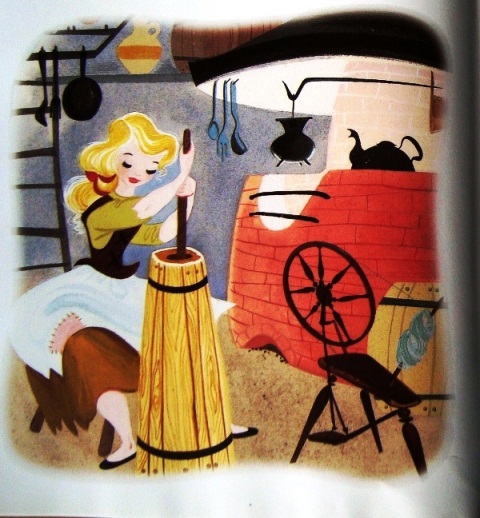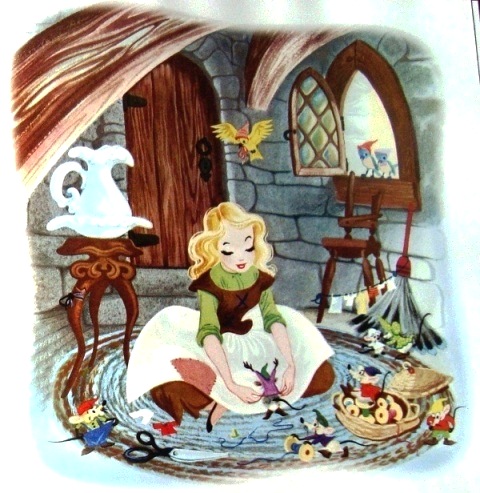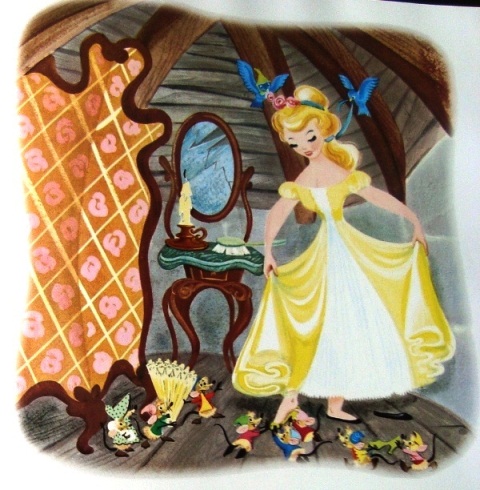JOYFUL MIND WELLBEING
|
I love coming across long-forgotten children’s books and thrilling at the pictures that once sparked an impressionable imagination. The Golden Book Cinderella is one such gem; my sisters Mary, Margie and I drooled over the doe-eyed heroine in her whimsical settings many years ago. Cinders in her yellow party dress with the bluebirds tying ribbons in her hair; Cinders seated comfortably on the floor in peasant attire, fitting hand-sewn outfits on obliging mice; Cinders churning butter, a black kettle on the hob in the background.
Today I live in a somewhat rustic bush residence with a stone fireplace that reminds me of Cinderella, particularly when I’m stirring the black cast-iron pot on the fuel stove. But rest assured, the similarity stops there! We’re enlarging our little bush house at the moment with a long-awaited new room. Which brings me to this blog topic. I’m noticing that we’re needing lots of makeshift blocks along the way to use as wedges in the building process. For example, small blocks of wood prop up the fibro sheets we paint; other blocks keep materials raised dry above wet ground; blocks choc window sashes; a plank serves as a temporary entrance ramp. The makeshift blocks aren’t part of the finished structure but they assist the build. They assist by creating space, necessary space, between one surface and another. (How I wish Cinderella was on the job to keep the kitchen running while we toil away on the building site, that would assist the build, too!) Space. Ahhh. Even the word is consoling in a cluttered world, and very appealing to a cluttered mind. What if we could use makeshift blocks to create space in our own crowded head? Let in the sunlight and a refreshing breeze? Well fortunately, we can. That’s where mindfulness and its tools come in. One such makeshift block, in the mindfulness context, is to use a special phrase that creates a space between an automatic thought and our uptake of that thought (think sunlight and refreshing breeze.) “Thank you Mind” is one such device and is recommended by psychologist Russ Harris: his best-selling book, The Happiness Trap, is an informative read. Although the word ‘thank you’ is usually a response to something positive, here it’s a way of addressing troublesome thoughts. We greet our circular thoughts with warmth and humour, and of course need to have our mindfulness in place in order to even notice them. “Thank you Mind” is like saying ‘I see you, troublesome thought’. We could equally as well say ‘hello mind’ or ‘that’s nice, dear’. Anything that works. The idea is to greet the presence of unhelpful thoughts, particularly the recurring, emotionally-charged type, with a brief verbal response. It’s like a nod or acknowledgment, a recognition that we know what’s going on in our mindstream, thank you very much, and we are in charge here. We are not going to be dictated to by repetitive thinking, product of the ruts formed by well-worn neural pathways in our brain. No, we will get to the Ball, and the Ball is our own glorious life of choice and open-hearted presence. Cinderella could have made good use of the “Thank you Mind” wedge. I bet she often felt hard done by, with the stepsisters taking over the accounts and she being relegated to the rags and the pots. In Cinderella’s case, she may have been tormented by the recurring mantra “Darn these snooty step-chicks, I’m outta here. Hey no, I’m totally stuck, povo, useless. Things will never improve. I’m a confirmed loser. Woe is me.” Stop a moment, Cinderella. Try “Thank you Mind” each time you notice the familiar inner rant (and you won’t notice every single time, but that’s okay). What happens? Do you get a whiff of fresh air, a sense of space, of fresh possibility? By inserting the phrase each time the familiar negative emotion surfaces, Cinderella will start to see how her own repetitive self-talk and reactivity generate her claustrophobia and prevents her making helpful choices. Of course, in the fairytale a handsome prince comes along and saves the day, but we’re not falling for that one, are we ladies? Harris points out that “Thank you Mind” is not about being judging or patronising towards our repetitive thoughts. Its role is simply to put a handy wedge between oneself and our thinking process. It’s a reminder that we are not our thoughts and we do not have to accept, chew and digest whatever the mind serves up. When we become more conscious, or mindful, of our thought processes and thinking habits we also become more free. It’s sobering to reflect that the thoughts we do not see are the ones that control us. In my own case, Thank you Mind can help me cope with the stress of building. Say we’ve put up the stud walls and are now ready to start on the roof. I spy a single grey cloud overhead and catastrophise: “Oh no, it’s going to storm, possibly for weeks and we’ll never get the roof up!” Thank you Mind. Then, ‘Oh no, he’s neglected to put the ant caps on the posts, we’ll be overrun by white ants for sure!’ Thank you Mind. “I haven’t got time for building anyway, I’ve got far too much else to do, there’s x, there’s y, there’s z (grumble, grumble, grumble): Thank you Mind. “Oh why didn’t he put ant caps on the posts, we’ll be overrun by white ants for sure!” Repetitive recurring thought: Thank you Mind! “Thank you Mind” pulls me out of rumination and its ghostly terrain; it gives me back the present and widens my perspective. (Cinderella, I wish you knew.) Trying circumstances will always come our way but we don’t have to jump aboard the gravy train of ‘poor me’, ‘bad them’, and fall prey to excessive semi-conscious rumination. With the makeshift block of “Thank you Mind” in our Mindfulness toolkit we can make the effort to break free and reconnect to the vibrancy of everyday life. We can harbour a joyful mind, even amidst our difficulties. Try it for yourself. Thank you, Thank you Mind. © Shakti Burke 2013 UPCOMING MINDFULNESS COURSE We’ll be playing with Thank you Mind and other similar devices through fun activities in my upcoming six-session Mindfulness course in Kyogle. Plus the usual tips on how to achieve inner focus and develop mindful awareness in daily life, alongside the more formal elements of guided relaxation and meditation. Course starts 21st October for six Monday evenings, 5.30-7.15 pm at the Seniors Centre venue in Blore St, behind the pool. Bookings, [email protected]
5 Comments
Yay, at last! I’ve finally created my own website. Remember how near-impossible it seemed to learn to ride a bicycle? Starting a website has been a bit like that. Scary at first but surprisingly easy and fun once up and riding.
I began by buckling my helmet of determination and pushing my bike of curiosity up a Google hill of website templates. I passed many varieties on the way, some sticking out on the hillside like ramshackle huts, others glamorous castles of design sophistication. I found something comfortably inbetween: Weebly. Once I’d discovered Weebly, the downhill sailing began. Wind in my hair, freewheeling, big blue sky. Relief: it can be done. Crash. Spoilt for choice. So many options. Grey headers, blue headers, chose your own colour. Tabs to the side or up above; big tabs, small tabs, medium tabs, flashing tabs. Put a single column here or a triple column there? And what about buttons, widgets and fonts? My pace slackens, hesitations at the roadside of doubt. (What if Wordpress would have been a better choice, or that other mob …) I peddle on. The Weebly instructions prove to be reliable roadsigns, simple and straightforward. You simply can’t go wrong: it’s all drag and drop. My ride takes me through hills and valleys, decision after decision. What to drag and what to drop? What to choose and what to lose? What tone to take, what ‘look’ to make? Bit by bit it all comes together. JOYFUL MIND I’ve chosen the name Joyful Mind because mindfulness brings more joy to our life as we grow in appreciation and lessen our addiction to rumination and automatic pilot mode. Mindful life brings the feel of a shiny new colourful bike rather than a rusty old jiggly one with squeaks and punctures. Even on the inescapably jiggly days, mindfulness is the bell on the handlebars that helps steer our way through the twisting laneways crowded with junk and potholes, the difficult times and uncomfortable headspaces we all encounter. Through mindfulness we discover a way of being present that infuses unwanted situations with space and clarity. It makes the difference between being stuck in our head with our clamouring thoughts and not being stuck. When life is going smoothly, mindfulness boosts our energy, enjoyment, relationships and life satisfaction. REPEATED EFFORTS Let’s park the bicycle metaphor at this point because the mindfulness process is profoundly different to bicycling. Once we’ve got the knack of how to stay upright and balanced on a bike, that’s it, we’re set. Not so with mindfulness. Mindfulness requires repeated efforts, repeated reminders. Over and over again. We’re challenging the habit of rumination and autopilot; changing habits means we’re changing neural structures in our brain. It takes time. The reward is life-changing. Wait up. It’s somewhat misleading to infer mindfulness itself requires effort: mindfulness is the easiest thing in the world. The hard part is remembering to do it. We need an action plan. Attending classes is helpful. A regular short mindfulness meditation practice at home is a reliable method for many people. The bottom line is to deliberately and frequently remind oneself to be present during routine daily tasks. Being present, we let go of the tension we’re holding in our body; we expose our largely unconscious mental chatter, we get a whiff of freedom. EFFORT AND EASE In my classes we often discuss the ‘effort versus ease’ aspect of mindfulness. I encourage participants to approach mindfulness practice gently: over-efforting is counterproductive. If someone’s feeling “I can’t do this, it’s too difficult” I suggest they’re trying too hard. Ease up. Once you’ve remembered to be mindful, you’re already mindful. There’s not something extra to add to that. Just be there. Perhaps we’re so unfamiliar with pausing- just pausing- it seems threatening. Perhaps we’re so familiar with straining that strain has become our habit. We wind up… wound up! How to wind down? Mindfulness is a holiday from straining, from trying too hard, from pushing and striving. It’s about letting go and letting be in all variety of situations and noticing what happens then. It’s about being non-judgemental about our reactions (another hard habit to break); self-compassionate (ditto); it’s about developing trust in our own instincts and inner guidance. And it’s about acceptance. Accepting what is happening in the moment brings clarity and is the first step on the mindfulness path; on the other hand, pushing away or applying force leads us deeper into the jungle. The attitudes just described are summarised by one word: mindfulness. The point is that the practice itself is the reward. The practice itself is the mindfulness! The absence of automaticity makes mindfulness a very fresh state: we refresh ourselves in the present again and again. This freshness is often likened to a ‘beginner’s mind’, new each time. We lose it whenever we grow complacent. The enjoyable refreshing quality to ‘being present’ feeds our new habit to be present and encourages us to push the mindfulness button again and again. We recognise that being ruminative or automatic takes us to a stale place and we want to clamber out. Thus effort becomes joyful effort; the whole meaning of ‘effort’ changes. Effort and ease intermingle because the reward comes straight away (providing our expectations don’t hide it). We discover that the journey itself is the destination. There is no distant goal. With mindfulness, we are already here. Thanks for reading . Please leave a comment if you’d like, it would be great to hear from you. © Shakti Burke 2013 Thanks to Libby Varcoe, web strategist http://www.writeminded.com.au, who came up to Lennox Head from Sydney last year to lend her sage advice through ArtsNorthern Rivers https://artsnorthernrivers.com.au/ and whose inspiration sparked this blog. |
Categories
All
Categories
All
|
ServicesYoga Online
Mindfulness Coaching |
|



 RSS Feed
RSS Feed